Steamed in a dashi-based sauce, this Instant Pot Chawanmushi is a savory Japanese egg custard made with seasonal ingredients. Delicate and silky smooth, it makes a perfect appetizer to start your meal!
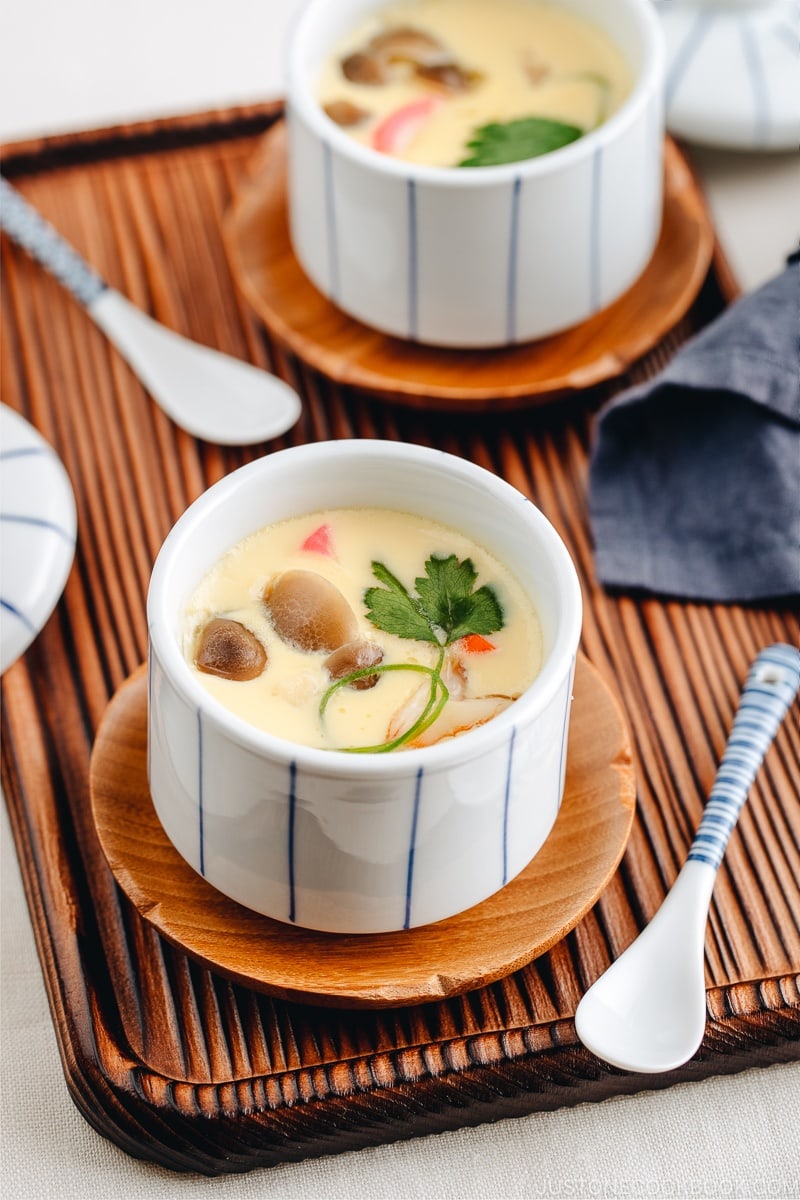
For the warmest and most welcoming appetizer to grace a Japanese meal, it always feels right to start with steaming cups of chawanmushi. Made with a dashi-infused egg mixture with the freshest seasonal ingredients, this Japanese savory egg custard is meltingly smooth and deeply flavored.
It is typically cooked in a traditional steamer or in a hot water bath, but if you happen to have an Instant Pot, you can easily make chawanmushi in the electric pressure cooker. When you’re busy making main and side dishes on the stovetop, Instant Pot Chawanmushi is particularly convenient and dependable.
The Perfect Ratio for Egg to Dashi
When you research what’s the best ratio for the egg mixture to dashi in Japanese, most of the websites would mention that the ratio is 1 to 2.5 (egg mixture to dashi by volume). Although it does not have to be exact, it’s good to know the basic ratio to start and you can adjust later as you like. [ml = g]
- 1 egg (50 ml) – 125 ml dashi
- 2 eggs (100 ml) – 250 ml dashi
- 3 eggs (150 ml) – 375 ml dashi (can make 5 200-ml ramekins)
- 4 eggs (200 ml)- 500 ml dashi
- 5 eggs (250 ml)- 625 ml dashi
- 6 eggs (300 ml)- 750 ml dashi (can make 10 200-ml ramekins)
- 7 eggs (350 ml)- 875 ml dashi
- 8 eggs (400 ml)- 1000 ml dashi
Note: It’s not common to have a kitchen scale (less than $15) in a typical American kitchen, so I try my best to give you the closest measurement possible using a liquid measuring cup. However, sometimes the “perfect” amount could display “between the lines” of the exact measurement. I often feel this could cause subtle differences/improvements in the final taste.
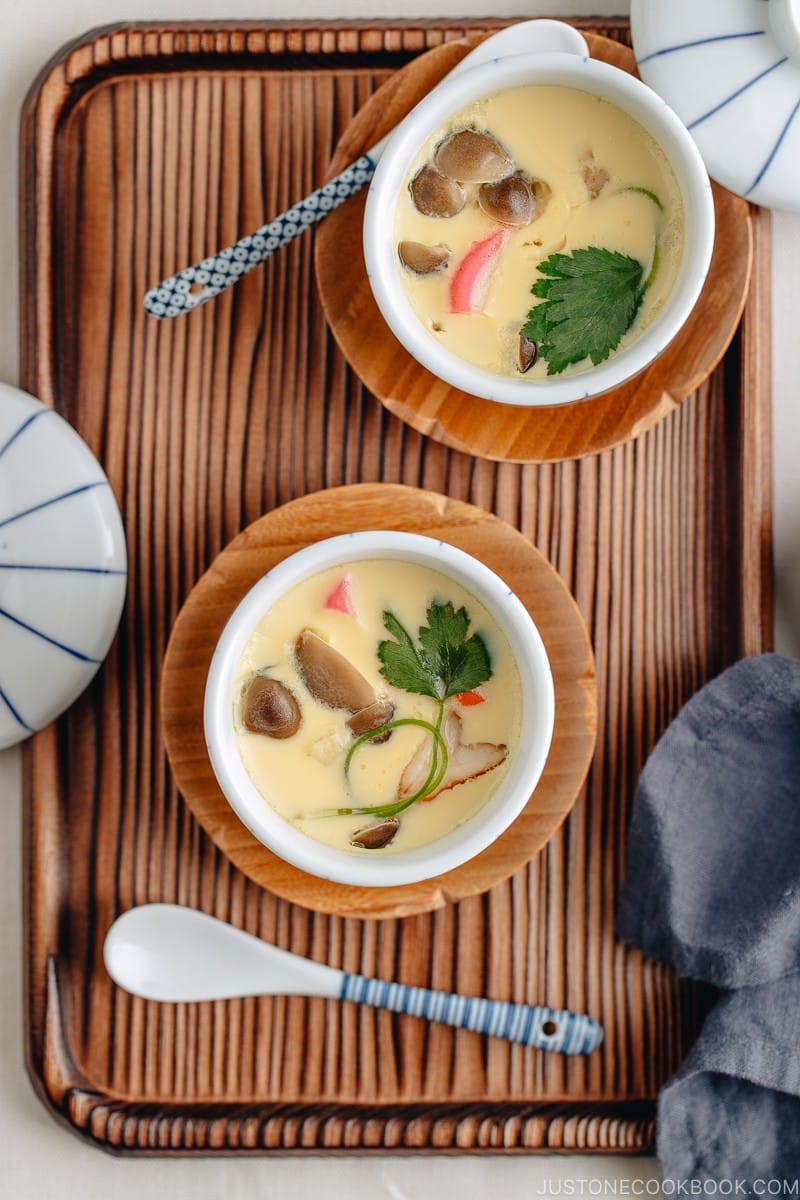
Tips for Soft and Silky Texture for Chawanmushi
1. Strain the egg mixture.
Straining the egg mixture helps separate any stringy egg whites strands so you get a smooth and silky custard.
2. Use gentle steam on the low heat setting.
When your chawanmushi has a porous texture with tiny visible holes, we call them “su”. These holes in the steamed egg custard are the indicator of strong heat or overcooking, hence it’s considered a failure. Your goal is to make chawanmushi without these holes. To achieve that, make sure to keep an eye on the cooking time and heat.
3. Check doneness by inserting a skewer.
If the clear juice comes out, it’s done. If the juice is not clear, you will need to cook it longer.
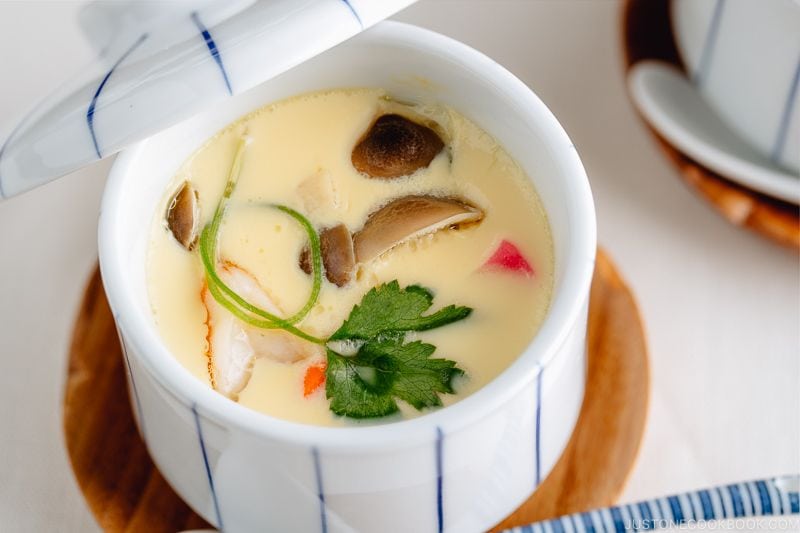
What if you don’t have an Instant Pot?
Don’t worry! Here are other methods to make chawanmushi:
Stovetop Steamer:
You can use a traditional steamer to make chawanmushi. You do not need to cover the steaming cups in this setting. Instead, you will wrap the steamer lid with a large kitchen towel so that condensation from the lid won’t drop into the chawanmushi while steaming. Place the steamer cups in the steamer and leave the lid ajar to let the hot steam escape. This creates a gentle steaming condition inside the steamer. Cook for roughly 18-20 minutes.
Stovetop Water Bath:
Boil water in a large pot that can fit the steaming cups. Once boiling, reduce the heat to the lowest heat. Gently place the cups inside the hot water and cover the pot with the lid. Cook for 18-20 minutes on the lowest heat.
Steam in the Oven:
Preheat the oven to 350 ºF (180 ºC) and fill a roasting pan (or deep baking dish) with 1″ (2.5 cm) boiling water. Cover the steaming cups with the lid or aluminum foil and place them inside the roasting pan. Cook for 25-30 minutes (cooking time varies based on your oven/steaming cups).
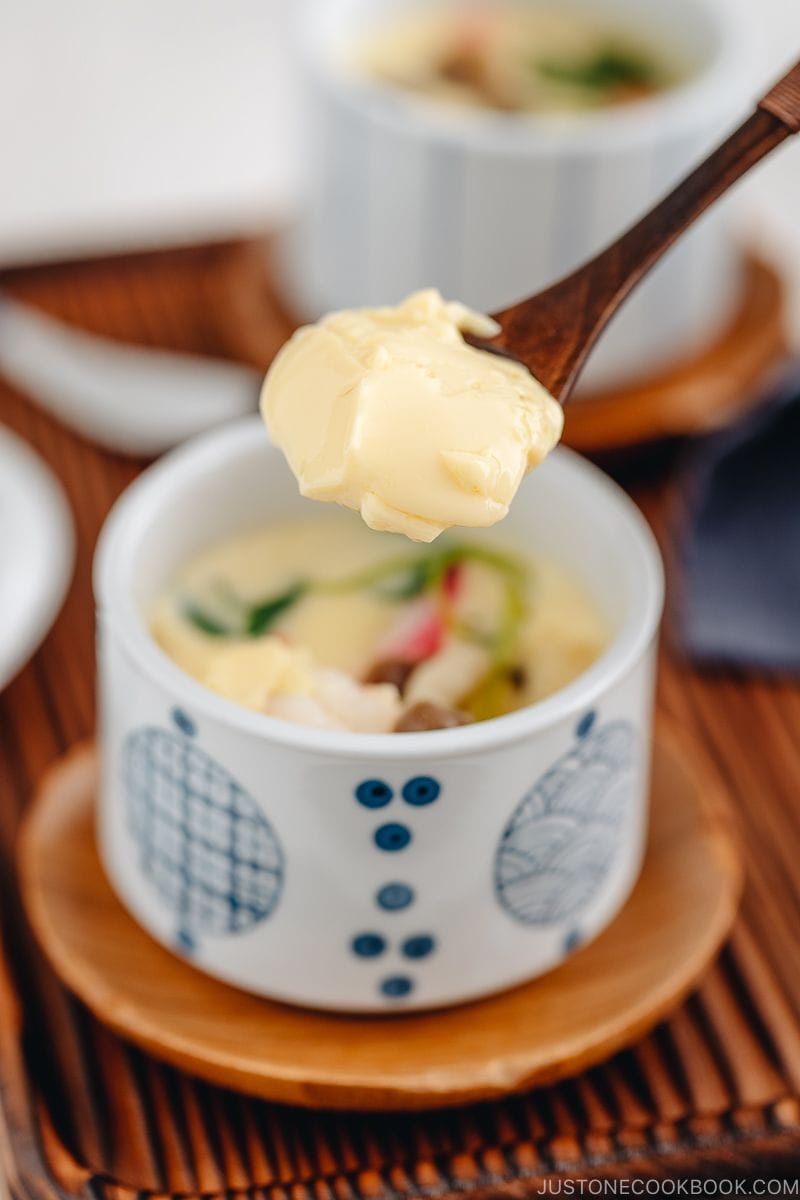
Substitution
- Chawanmushi cups – Use ramekins or oven-safe containers. You can use aluminum foil to cover it.
- Dashi – Do not skip. The flavor of chawanmushi relies heavily on dashi. For vegetarians, you can use Kombu Dashi. I use Awase Dashi (kombu + katsuobushi/dried bonito flakes).
- Eggs – Try to use good-quality eggs for this dish.
- Usukuchi (light color) soy sauce – This type of soy sauce is used especially in the west of Japan (Kyoto and Osaka). The light color soy sauce will keep the broth light in color. It is commonly used for dishes like chawanmushi, noodle soup, and clear soup. You can use less regular soy sauce and add a pinch of salt.
- Mirin – Small amount, but this is one of the essential Japanese ingredients (read here). If you don’t have it, use sake/water + sugar.
- Chicken thighs – You can use chicken breast or chicken tender. We do not use other types of meat for chawanmushi.
- Shrimp – You can use other seafood of your choice or skip it. If your shrimp are large, cut them in half so they will cook faster.
- Shimeji mushrooms – Use your favorite mushrooms.
- Kamaboko (fish cake) – You can use different types of fish cakes (cut into similar sizes and thicknesses) or skip them.
- Mitsuba (Japanese parsley) – Use chopped chives, green onion, or a few leaves of cilantro.
The seasonal ingredients in this chawanmushi are a delicious treat, but even if you simplify it, your homemade chawanmushi will still taste wonderfully luxurious. I know you’d enjoy this ethereal egg custard!
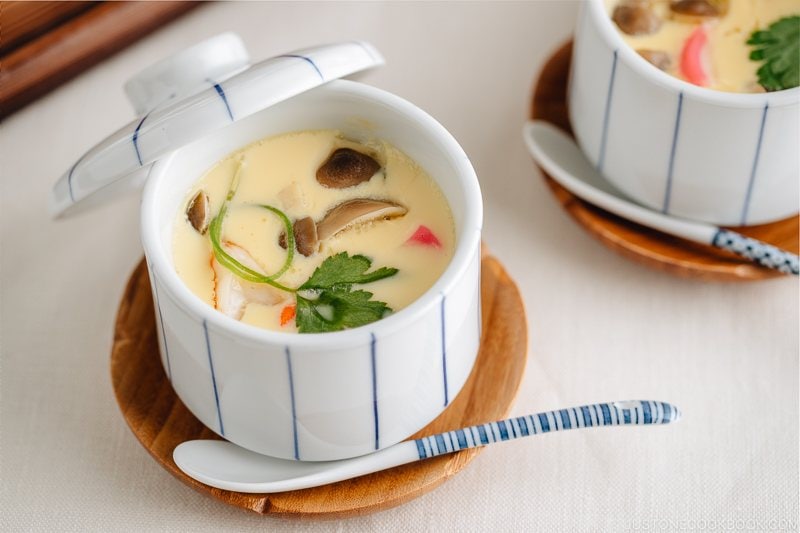
Wish to learn more about Japanese cooking? Sign up for our free newsletter to receive cooking tips & recipe updates! And stay in touch with me on Facebook, Pinterest, YouTube, and Instagram.

Instant Pot Chawanmushi
Video
Ingredients
For the Egg Mixture
- 1¾ cups dashi (Japanese soup stock) (for vegetarian, make Vegan Dashi)
- 3 large eggs (50 g each w/o shell)
- 1 tsp mirin
- 1 tsp usukuchi (light-colored) soy sauce (or use regular soy sauce or gluten-free soy sauce for GF; we use light-color soy sauce so the broth doesn't get dark)
- ½ tsp Diamond Crystal kosher salt
For the Chawanmushi Ingredients
- 1 chicken thigh (3.4 oz, 96 g; skip for vegetarian)
- 5 shrimp (2.6 oz, 73 g; skip for vegetarian)
- 2 Tbsp sake (divided; for the chicken and shrimp)
- 1.4 oz carrot (1½ inches, 3.8 cm)
- 5 sprigs mitsuba (Japanese parsley)
- 2.3 oz shimeji mushrooms (a bit more than ½ package)
- 1 inch kamaboko (fish cake) (skip for vegetarian)
Instructions
To Prepare the Ingredients
- Gather all the ingredients. If you haven‘t prepared 1¾ cups dashi (Japanese soup stock) yet, make the standard awase dashi and let it cool to room temperature (you can place the pot with dashi in it over a bowl of iced water).

- Cut 1 chicken thigh into slanted, smaller bite-sized pieces. I use the sogigiri Japanese cutting technique to create more surface so it will cook faster.

- Put chicken pieces and 5 shrimp in two separate bowls and add 1 Tbsp sake to each bowl. This is to remove any unwanted smell from the chicken and shrimp.

- Cut 1.4 oz carrot into ¼-inch slices. The next step is optional, but you can cut out the carrot slice into a flower shape by using a vegetable cutter or use the nejiri ume Japanese cutting technique.

- Make a knot in each stem of 5 sprigs mitsuba (Japanese parsley).

- Cut and discard the bottom end of 2.3 oz shimeji mushrooms and slice 1 inch kamaboko (fish cake) into thin slices.

To Prepare the Egg Mixture
- It’s best to use a kitchen scale but if you don’t have one, use a liquid measuring cup. Crack 3 large eggs (50 g each w/o shell) in a large bowl on a kitchen scale (or in the liquid measuring cup). My 3 eggs are 153 grams or 153 ml. You will need to multiply that number by 2.5 (read the blog post on why we multiply by 2.5). 153 x 2.5= 382. Prepare 382 grams (or ml) dashi.

- Transfer the eggs into a large bowl that can fit dashi and seasonings and whisk the eggs.

- Add dashi (382 ml), 1 tsp mirin, 1 tsp usukuchi (light-colored) soy sauce (or regular soy sauce), and ½ tsp Diamond Crystal kosher salt. Whisk all together.

- Pass the egg mixture through a strainer/sieve into a liquid measuring cup (for easy pouring later on).

To Assemble
- Place the ingredients in each chawanmushi cup or ramekin. You want to show the colorful ingredients on top, so put the non-colorful ingredients like chicken on the bottom. Put more colorful or unique shape ingredients toward the top.

- Evenly distribute the egg mixture into chawanmushi cups. Place the mitsuba on top.

- Cover the chawanmushi cups with lids or wrap with a sheet of aluminum foil (if you are going to stack one on top of another).

To Steam in the Instant Pot
- Fill the instant pot with 1 cup water. Set the steamer rack in place.

- Put the chawanmushi cups inside. The 5th chawanmushi cup goes on top of the 4 cups.

- Close the lid and click STEAM, make sure it’s LOW pressure and set the timer for zero (0) minute.

- It will take about 10 minutes to reach the optimal pressure. Then beep for 0 minute. Then it will naturally release. Set your own timer for 10 minutes natural release.
- At 10 minutes alarm, open the lid and take out one chawanmushi cup and go to the next step. If the lid doesn’t open, then it means the pressure hasn’t fully released yet. Prepare a kitchen towel and turn the nozzle to release pressure. Only a little bit of steam should be left, so don’t be scared. Once the pressure has released, you can open the lid.

- Open the chawanmushi cup lid (or aluminum foil) and insert a skewer to see if the egg custard is fully cooked. If the custard look set and there is no liquid coming out, it is fully cooked.

- If the chawanmushi is not fully cooked yet (most likely your container is bigger than my chawanmushi cups OR you must have used a colder egg mixture or ingredients), repeat the steam process, and release the air pressure manually. Remember, the egg mixture will continue to cook through from pre- and after- pressure cooking time.
- Place the chawanmushi lid on and serve hot with a small spoon.

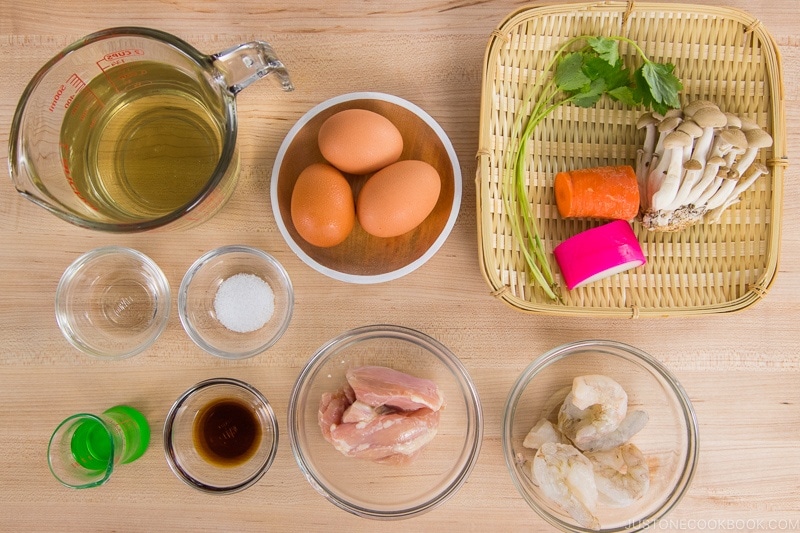
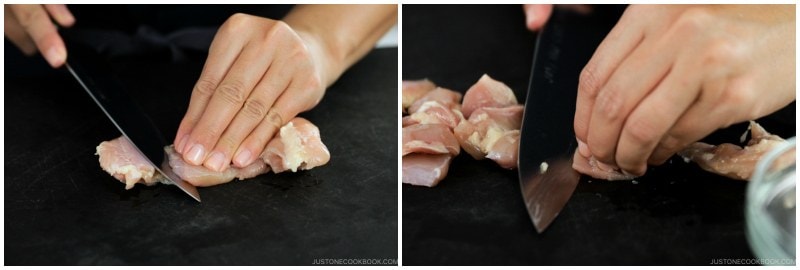
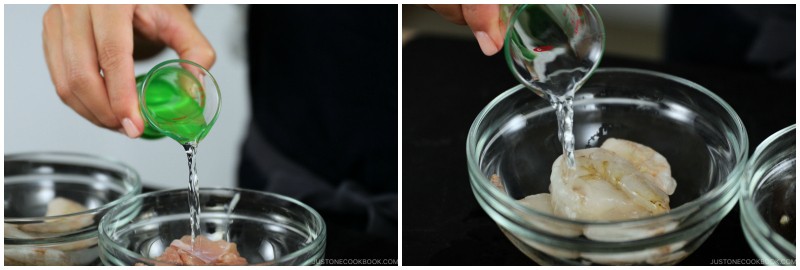

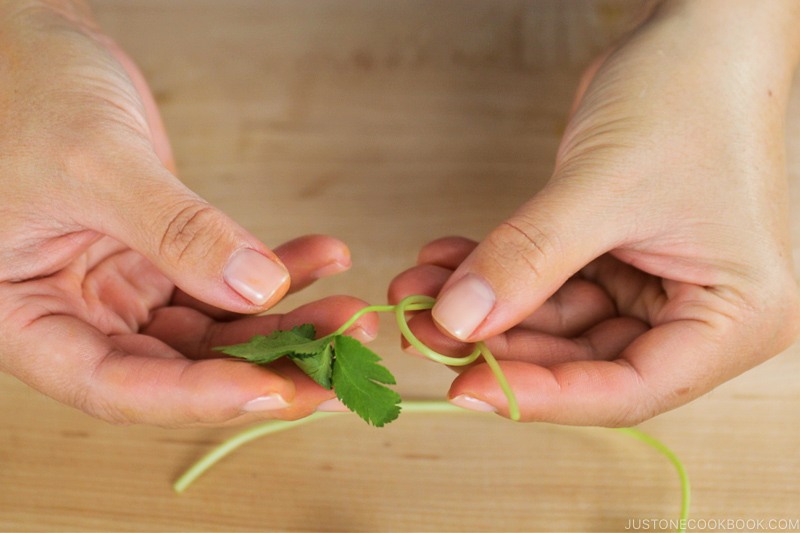
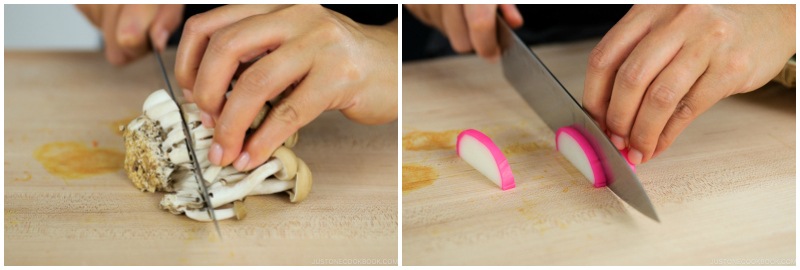
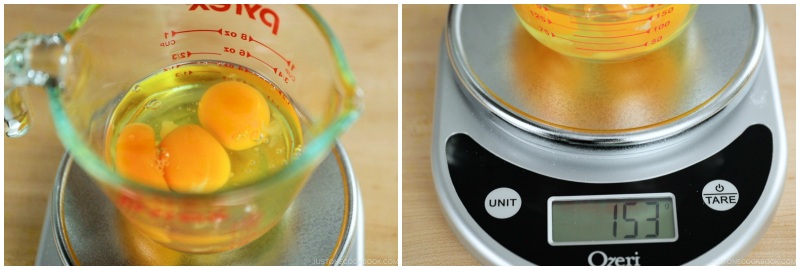
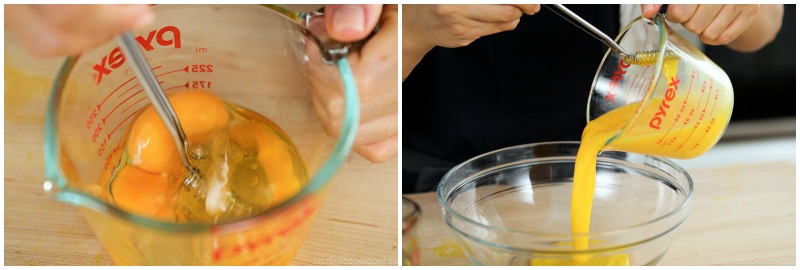
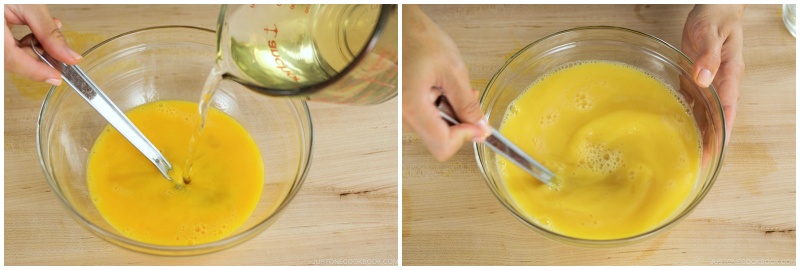
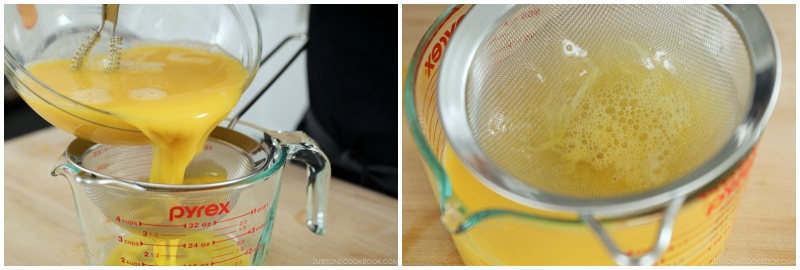
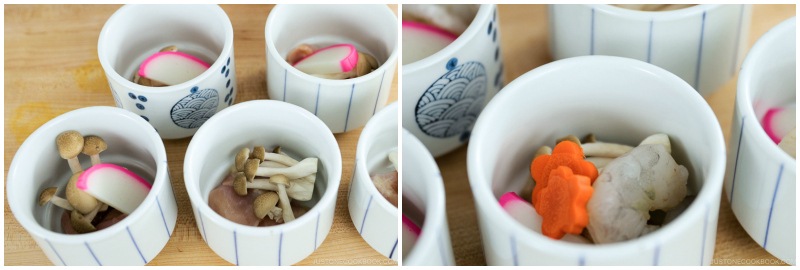
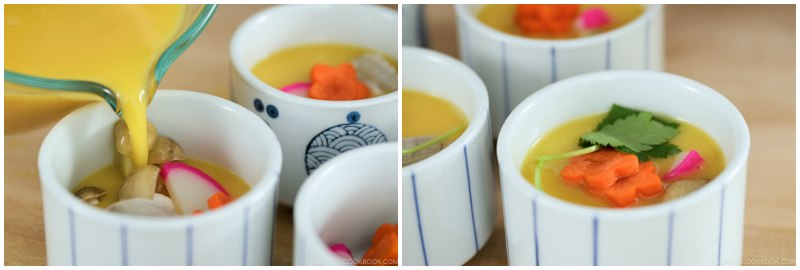
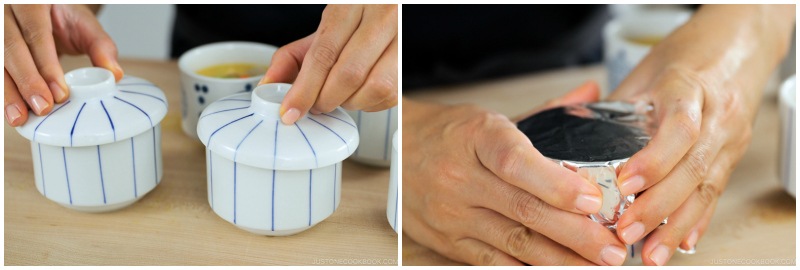
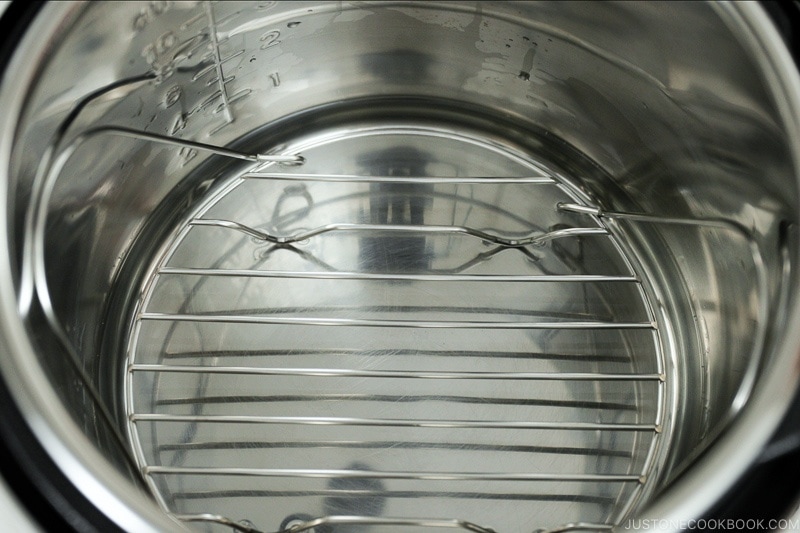
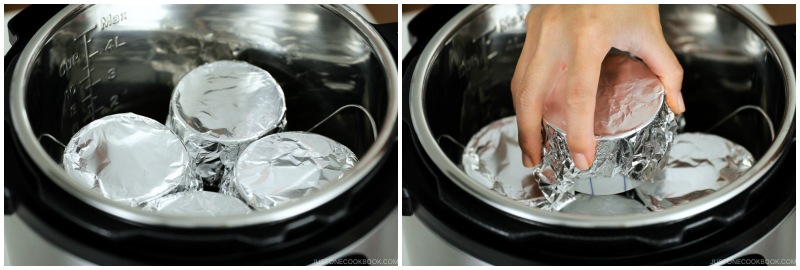
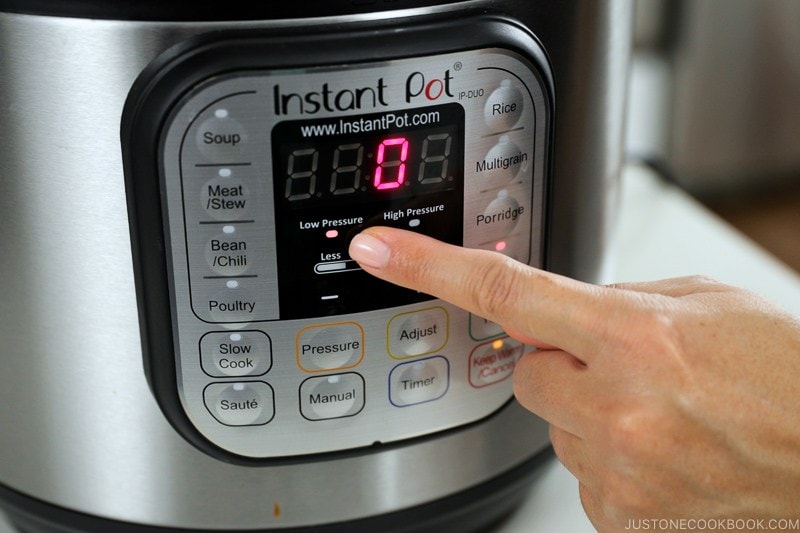
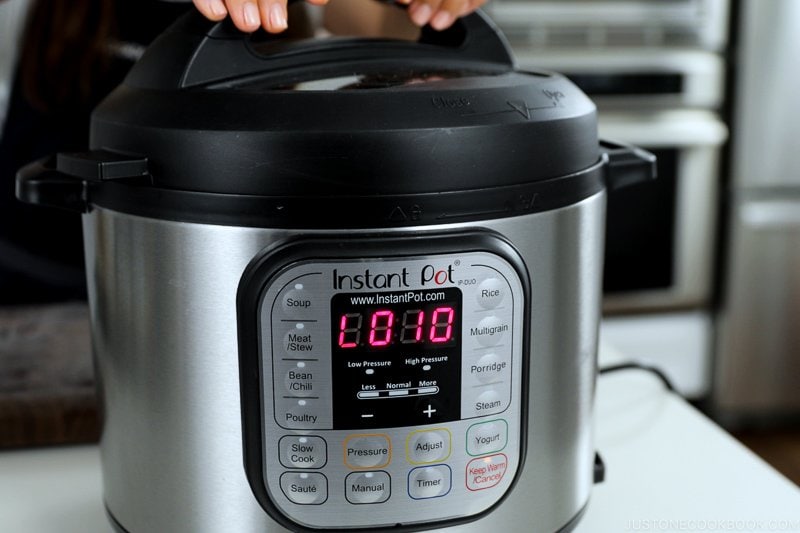
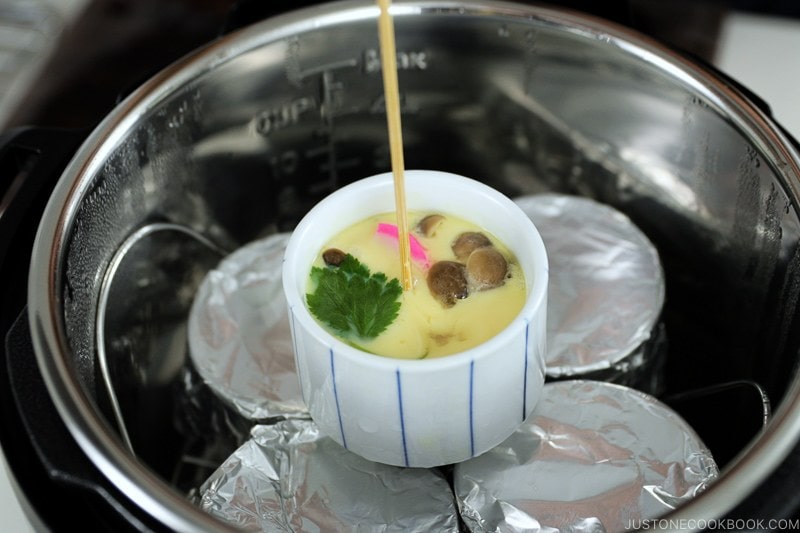
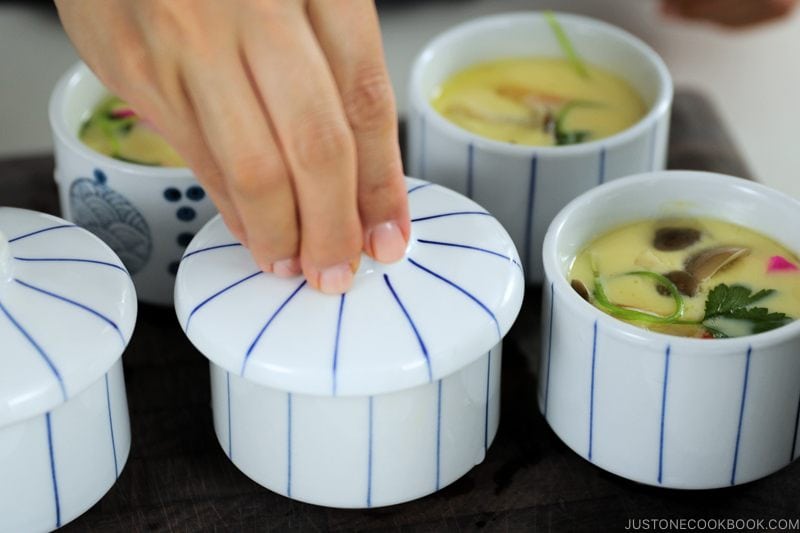










Can I prepare this in advance?
Hi, Michiko! Thank you for trying Nami’s recipe.
You can prepare them ahead of time, keep them in their cups, and refrigerate them for up to two days. To reheat, steam for two minutes.
We hope this helps!🙂
Thank you for another dependable IP recipe. If I were to prepare this for a dinner party (and like to impress my guests 😉), how would you suggest to keep the first batch warm while steaming the 2nd or 3rd batch? Thanks.
Hello, Karen. Thank you for trying Nami’s recipe!
Placing the Chawanmushi cup in warm water is the best way to keep it warm.
You can also make a large batch of chawanmushi in the oven instead of in the instant pot if you like. This post includes instructions for making this in the oven.
We hope this was helpful!
Hi Nami, is it okay if I sub dashi with chicken stock?
Hi Bella! Sure, you can use chicken stock if you prefer.
Thank you so much for trying Nami’s recipe!
[…] herb that resembles Italian parsley. It’s used as a garnish in miso soups, rice bowls, chawanmushi, or folded into tamagoyaki. An herb native to East Asia, the entire plant, from the root, stem, […]
Absolutely perfect. This recipe made 4 portions (not 5) as my cups are probably larger. Used only mushroom and pea shoot (what I had). Adjusted time to 12 min…it was perfect! Thank you!
Hi Jacqueline! Your Chawanmushi looks perfect!
Thank you very much for trying Nami’s recipe and sharing your cooking experience with us!
What’s the advantage of using the instant pot over just steaming it?
Hi Alex! Thank you for reading Nami’s post!
As she mentioned in this post, you can use another method to make Chawanmushi.
But if you happen to have an Instant Pot, Instant Pot Chawanmushi is particularly convenient and dependable when you’re busy making main and side dishes on the stovetop. 😉
The flavours of this recipe are so good. For some reason, mine were still pure liquid after steaming for zero minutes on low pressure. I steamed it a second time with a quick release and this time it set nicely, but with bubbles at the top. Does this mean the custard was over cooked? It was still silky smooth underneath and the chicken washer tender. Made it for Mother’s Day along with other dishes and this was my mom’s favourite of the evening. Thank you, Nami-san!
Oh—I just read another user’s post about needing to have the Keep Warm option on. I’m not sure if mine was on or off. That could explain things. It it WAS on and still came out liquid, what might have been the cause?
Hi Angela! Yes! Please keep it the “Warm” option!
If it was on and still came out liquid, it could be from the missed measurement of the egg and dashi ratio.
Also, please know that Chawanmushi should have a clear liquid and soft egg pudding in the cup. (See the Chawanmushi video 4:26 for more view.)
We hope this helps!
Hi Angela! Thank you very much for trying Nami’s recipe!
We are glad to hear your mom enjoyed Chawanmushi!🥰
Please make sure to use the “Keep warm” setting after the Instant Pot had finished pressurizing so that the remaining heat can continue to cook Chawanmushi.
The bubbles at the top could be from the air was trapped in the egg mixture. You can try using a fine strainer/sieve to reduce the bubbles next time.
We hope this helps!
Just made this and it was perfect! I used dashimoto (1 pack in 2.5 cups) and 3.75 c with 3 eggs… yummy!
Hi Lily! Thank you very much for trying this recipe and for your kind feedback!
We are glad to hear you enjoyed Chawanmushi!
Sorry, I meant to say 1.75 c of the Dashi with 3 eggs…
I finally figured out why I kept getting this recipe wrong! The 10 minute release needs to have the keep warm setting on or else it won’t cook properly. I noticed that by looking at the photo of your instant pot. I always turn keep warm off by habit, so people who do the same might get the recipe wrong if they just read it. When I used keep warm today it came out great though!
Hi Daniela, Thank you very much for trying this recipe and sharing your cooking experience!
We are glad to hear you enjoyed Chawanmushi.
Mine tasted great and looked set when I took it out the instant pot, but it separated as soon as I put a spoon in it. It separates into water (clearer than the original dashi) and egg. Is it undercooked?
Suggestions online also seem to suggest that it might be too much heat or too much dashi. I used 2.5 to 1 and the low pressure setting, and re-steamed it once. If I have to re-steam it several times, would it make more sense to, for example, set the steam time to 5 minutes instead of zero–and experiment with the time.
Hi Ralph, Thank you very much for trying this recipe!
It sounds like yours come out perfect. If the liquid and egg separate, it is done successfully!
Please watch Nami’s video (at 4:26) in this post so that you can see the close-up of Chawanmushi.
We hope this helps!
Looks like I was too critical of myself! That’s been known to happen… 😁
It was delicious! Thank you.
No problem, Ralph!! It is always good to check!
Thank you very much for trying Nami’s recipe and for your kind feedback.🙂